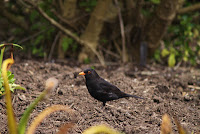New Zealand Birds
By Kate Crowley
As soon
as I saw the kookaburra, the song started playing in my head, “Kookaburra lives
in the old gum tree, merry, merry old……”
I don’t know how often I sang that song in school or at Campfire Girl
gatherings, but I never could have imagined as a child that one day I’d see the
real live bird in the wild. This kookaburra however was not sitting in a gum
tree. It was perched on a wire alongside
a road on the North Island of New Zealand.
The kookaburra is a native of Australia and was introduced like so many
others here.
New
Zealand, having been separated from Australia for millions of years had its own
unique flora and fauna. But as soon as people arrived, the composition began to
change. Native birds were killed off –
the Moas (there were nine species) being the most famous. These birds were
bigger than the ostrich (12ft) and had hair-like feathers and no vestigial
wings. Its big size and unfamilarity
with a predator as efficient as man brought it to extinction by the Maori, the
first people to arrive here. The Maori
also brought (unintentionally) the Pacific rat and domestic dogs. When the Europeans
hit the shores in the 1800s they introduced
the stoat to control the already introduced rabbits and cats, which
quickly and easily caught and ate the adults and eggs of birds who never knew
any predators. Next, people began cutting down the forests to make pasture for
grazing animals and so habitat loss became another factor. Some people also brought
caged songbirds to remind them of home and before long these birds were living
happily as free flying newcomers too.
What all
of this means is New Zealand has the sad distinction of having lost some 50
species - a higher proportion of its native birds than any other place in the
world! All of this history has been
repeated across the world. This is
nothing new; it’s just that with islands, it has a greater and more noticeable
impact.
Even
knowing all this, Mike and I have been like kids in the proverbial candy shop;
our eyes feasting on all the new and delectable sights of a land completely new
to us. As soon as we got out of the
airport, we were looking for birds. Not
surprisingly, the first we saw were English sparrows, but soon new species were
being added to our life lists. Some
birdwatchers travel specifically for this reason. It is an all-consuming passion (one might say
compulsion). For us, the excitement that
comes from seeing something unique and beautiful is more than sufficient. We are adding memories to add to our overall
life list.
 On our first day in the country we visited the
Auckland Botanical Garden and our sightings included the Blackbird (its common
name), with its all black body and bright orange bill. It is the size of an American
robin, which makes sense because it is a thrush like ‘our’ robin and it behaves
the same way, hopping around on lawns looking for food. Next was the song thrush which looks very much
like a wood thrush or Swainson’s thrush.
Both the blackbird and the thrush are introduced species, but completely
new to us.
On our first day in the country we visited the
Auckland Botanical Garden and our sightings included the Blackbird (its common
name), with its all black body and bright orange bill. It is the size of an American
robin, which makes sense because it is a thrush like ‘our’ robin and it behaves
the same way, hopping around on lawns looking for food. Next was the song thrush which looks very much
like a wood thrush or Swainson’s thrush.
Both the blackbird and the thrush are introduced species, but completely
new to us.
A larger
and very noisy bird we encountered in the Garden was the Tui (a Maori
word). There were loads of them flocking
to the Pohutukawa trees, which were covered with red bottle brush shaped
flowers. They are called Christmas trees here because of this. I wish I could describe the calls of these
birds for you, but I will use the filed guide’s description. “An amazing range
of noises, a mixture of melodic and guttural tones, wheezes, croaks, coughs, and
chuckles”. I would add squeaks, chirps
and whistles to the list.
The
Tui, when seen in the sun, has a dark blue/black body with iridescent green and
blue feathers on its back. It also has a
goofy looking little white tuft of feathers that stick out at the throat, like
a bowtie. These caused the English to
call it the Parson. The birds are more vocal at breeding season in the spring,
which is right now in New Zealand. Apparently
the Tui is a bit like a mascot for some businesses and products, since their
image and name is seen on packaging and store fronts.
As
we crossed over a bridge near a pound, we saw swallows swooping back and
forth. One little fellow landed on the
railing and sat calmly as Mike snapped photos.
It very much resembled a barn swallow, with a copper color on its forehead
and throat, blue black feathers on its back, and a forked tail. Its common name seemed most appropriate on
this day. It is called the Welcome
swallow.
My
last column talked about gulls and I have to say that I have now seen the
prettiest one in the world. It is called
the red-billed gull. It is slightly
smaller than a ring billed, with lipstick red legs, bill and ring around its
yellow eye. I suppose they would grow
less stunning over time, but any bird that wears that shade of red so well
could never be called common.








Comments
Post a Comment